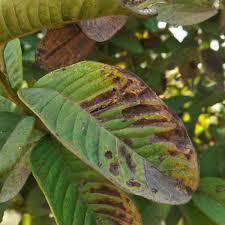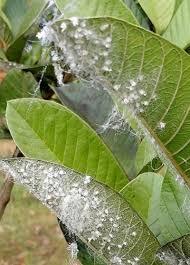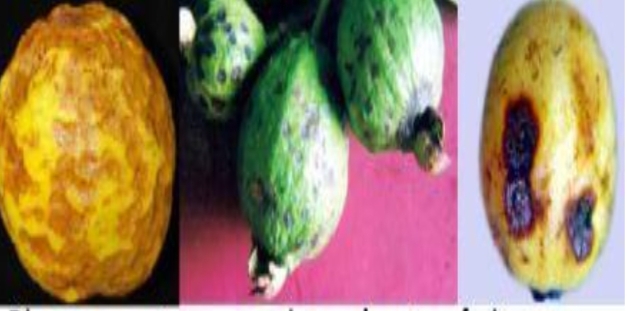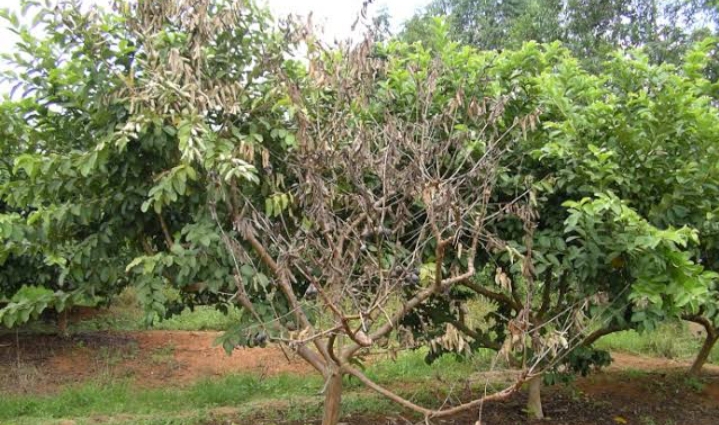Guava Plant
Guava trees, with a fast growth rate, thrive in well-drained soil and full sun. Hardy in zones 9-11, they produce delicious fruits.
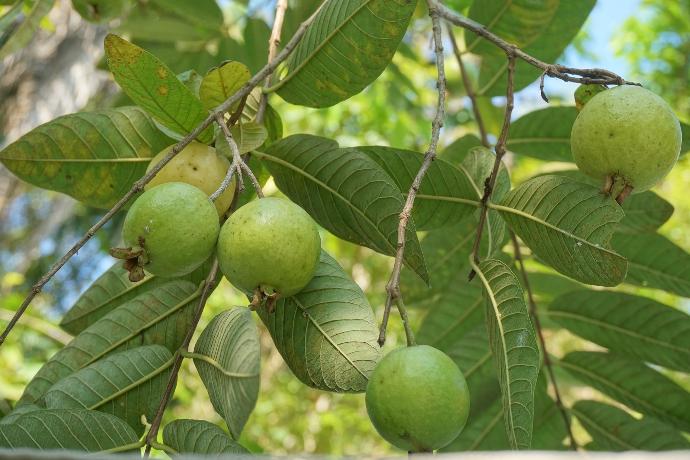
Habit
Tree
Height
10-30 ft
Growth
Fast
Soil
Well-drained, loam
Shade
Full Sun
Moisture
Moderate
Edible
Yes
Medicinal
Yes
Origin
Americas
Climatic Condition
Tropical, Subtropical
Temperature (°)
20-35°C
Humidity (%)
50-80
Potting media
Loam, compost
Fertilizers
Organic
Watering
Regular
Plant Weight
100-300 g
Flowering Time
Year-round
Soil Ph level
5.5-7.5
Water Ph level
6.0-7.5
Soil EC
1.0-1.3
Yield Per Plant
50-100 kg/tree
NPK ratio
10:10:10
life Span
50+ years
Health Benefits
Rich in vitamin C, digestion aid
Suggested Grow Media or Potting Mix ?
50% loam, 25% compost, 25% sand
Suggested Fertigation/Fertilizers
Fertilize every 6 weeks with a balanced fertilizer.
Common Diseases and Remedies
Anthracnose , Wilt
Infected Leaves exhibit brown or black spots, Yellowing and necrosis of leaves
Prue infected branches
What Is A Guava Tree?
Guava is a highly cultivated fruit known for its nutritional value and adaptability to many climates. It generally grows in hot weather, well-drained soil and rain. Guava trees require regular pruning and maintenance to encourage fruit production and disease resistance. The fruits usually grow 3-4 months after flowering and are harvested when they reach size, color and aroma. Guava cultivation can be a profitable investment as the demand for fresh and processed fruits is high.

What are the different types of guava plant ?
There are many species of guava plants, each with its own characteristics and qualities:
1. Common guava (Psidium guajava):
This is a variety of guava. It produces medium to large fruits with green or yellow skin and white or pink flesh. Overall, guava is versatile and can be eaten fresh, juiced, or used in many types of cooking.
2. Apple guava (Psidium guajava "apple"):-
Also called "Thai guava" or "crispy guava", this variety produces round fruits that resemble small apples. They have a crunchy texture and sweet taste. The juice is often eaten fresh or used in salads and desserts.
3. Strawberry guava (Psidium cartianum):-
Also called “cow guava” or “purple guava,” this variety produces small red or yellow fruits that taste reminiscent of strawberries. These fruits are often eaten fresh or used to make jams, jellies and drinks.
4. Feijoa (Acca sellowiana):-
Although not technically a guava, feijoa is sometimes called "pineapple guava" due to its pineapple-like taste. It produces green-skinned, sweet and sour fruits like eggs. Feijoa fruit can be eaten fresh or used in cooking and baking.
5. Red Malaysian guava (Psidium guajava 'Red Malaysia'):-
The fruits of this variety are large, with red skin and red flesh. It has a sweet and tangy taste and is often eaten fresh or used to make juices and jams.

How to Care Guava Plant?
1. Location :
Guava plants generally grow outdoors in subtropical and tropical regions that receive full sun and warmth. However, in regions with cold weather or limited outdoor space, guava plants can be grown indoors if sufficient sunlight and proper care are provided. To grow indoors, place your guava plant near a sunny window that receives at least 6-8 hours of sunlight per day. Additional lighting with grow lights may be necessary, especially in winter when daylight hours are short.
2.Sunshine:
Guava plants need sunlight to grow and bear fruit. Ideally, they should be planted in a location where they will receive full sun for at least 6-8 hours per day. In hot climates, partial shade during the hottest parts of the day can help protect leaves and fruit from the heat.
3.Soil:
Guava plants do not tolerate waterlogging, so the soil must have good drainage to prevent water from escaping from the roots. Soft-textured sandy loam or loam soil is ideal. Guava plants benefit from fertile soil rich in organic matter. Adding compost or rotted manure to the soil before planting will increase fertility and provide essential nutrients for good growth.
4.Hydration:
Water the newly planted trees regularly to create a solid foundation. Water deeply but rarely, allowing the soil to dry out a bit from the water. It is designed to keep the soil evenly moist but not waterlogged. Guava trees are drought tolerant once established, but they still need regular watering, especially during the dry season. Water deeply to encourage root growth and direct water to the root zone rather than overhead. Irrigation frequency depends on factors such as soil type, weather conditions and growth stage. In general, guava plants need to be watered every 1-2 weeks, but this will be adjusted based on humidity and environment.

5.Nourishment:
For good growth and fruit production, guava plants need good nutrition containing essential nutrients such as nitrogen (N), phosphorus (P) and potassium (K), commonly known as NPK fertilizer. Nitrogen is important for growth, leaf growth and all important plants. Guava plants often benefit from fertilizers with higher nitrogen content throughout the growing season to encourage lush green foliage. However, excess nitrogen can inhibit plant growth, which can reduce fruit yield. Phosphorus plays an important role in root growth, flowering and fruiting. A fertilizer with balanced phosphorus content will help your guava plant have healthy roots and blooms. Phosphorus is crucial for promoting fruit development during the flowering and fruiting stages.Potassium supports all plant health, stress and fruit quality. It helps control water absorption, increases resistance to diseases and improves fruit flavor and color. Guava plants benefit from the addition of potassium throughout the growing season, with a slightly higher amount used during fruit production.
6.Issues:
Guava plants may face many problems related to pests, diseases, environment and culture. Guava plants are affected by pests such as fruit flies, aphids, scale insects, mealybugs and guava moths. These pests can damage leaves, flowers and fruits, reducing yield and quality. Guava plants can be affected by fungal diseases, viruses and diseases such as anthracnose, powdery mildew, root rot, wilt disease and guava rust. These diseases can cause leaf, fruit rot, wilt, and overall plant damage.
What are the benefits of guava plant?
Nutritional value
Strengthens the Immune System
Digestive Health
Heart Health
Weight control
Cancer Prevention
Skin health
Environmental Services

FAQ's About Growing Guava Plant
1.How to maintain guava plant ?
Caring for the guava plant has many important tasks to ensure its health, productivity and longevity. Water your plants regularly, especially during dry periods, so that the soil always remains moist but not waterlogged. Water deeply to encourage root growth and avoid overwatering to prevent fungal disease. In spring and late summer, use a fertilizer with a balance of nitrogen, phosphorus and potassium suitable for your fruit tree, such as 10-10-10 or 8-8-8. Follow manufacturer's instructions for application and timing. Prune guava plants annually to remove dead, damaged or diseased branches, improve air and sunlight access and maintain balance. Pruning also encourages new growth and fruit production. Monitor guava plants regularly for pests such as fruit flies, aphids, scale insects and diseases such as anthracnose and powdery mildew. Use cultural practices such as proper pruning, pruning and insect-resistant varieties to reduce problems. Treat organically or chemically if necessary, according to recommendations from your local agriculture department.
2.What is the use of the guava plant?
Edible Fruit
Medical use.
Cosmetics
Beverages
Animal Feed
3.Can guava grow at home?
Yes, you can legally grow guava plants at home. Although guava plants grow naturally in warm climates and prefer full sun, they can be adapted to an indoor environment with proper care. Guava plants need full sunlight to grow and bear fruit. Place your guava plant near a sunny window where it will receive at least 6-8 hours of direct sunlight per day. If natural sunlight is limited, consider using grow lights to provide enough light for plants to grow. Guava plants prefer warm temperatures and cannot tolerate cold or temperatures below 10°C (50°F). Maintain indoor temperatures between 18-29°C (65-85°F) to encourage growth and fruiting.
4.What is the best pot to grow guava plants?
When growing guavas in pots, it is important to choose a well-drained and stable container with enough room for the roots to grow. Choose a large pot with enough space for the roots of the guava plant to spread out. For growing individual guavas, it is recommended to use a pot that is at least 24-30 inches (60-75 cm) in diameter and 18-24 inches (45-60 cm) deep. Large containers can increase the growth of your guava tree, encouraging better fruit production. Make sure there are enough holes in the bottom of the pot so that excess water can drain out freely. Proper drainage is important to prevent standing water, which can cause root rot and other problems. You can add a layer of rocks or broken plates to the bottom of the pot to improve drainage.
5.Where to buy guava plant?
You can purchase guava plants from many places, including local nurseries, nurseries, online plant stores, and farm supply stores. Visit a local nursery, nursery or nursery in your area that specializes in trees and shrubs. They can especially bring guava plants which are essential for your safety and growth. Many online plant stores carry many types of fruits, including guava plants. Look for reputable online nurseries or plant stores that deliver to your location and browse their inventory of guava plants.
